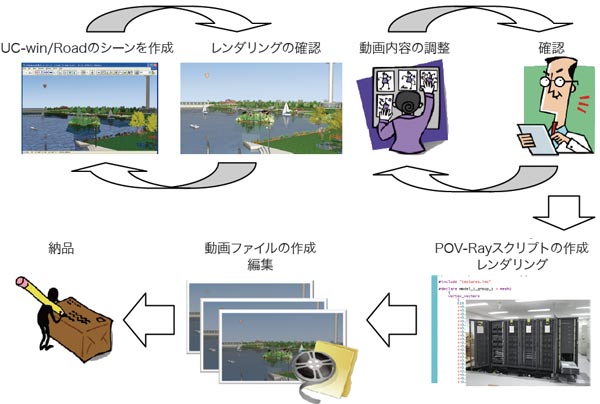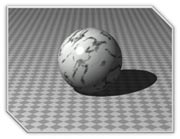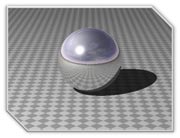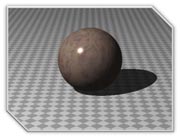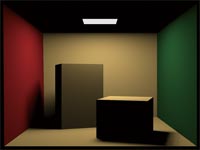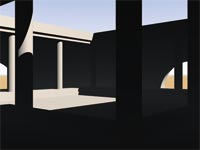UC-win/Road supports for output of AVI and POV-Ray with plug-ins, and this
function was improved for this update.
Movie option: AVI option and POV-Ray option are integrated
AVI option and POV-Ray option are integrated for the movie option to export
the POV-Ray script of the scene by frame.
The scene is output to the POV-Ray script per frame at the time of export
to AVI frame depending on the size, the number of frame of FPS set in the
AVI-Option window. At this timing, the AVI frame image is output as well
as the addition of frame to AVI and the output of POV-Ray. The movie contents
can be checked by using the AVI and AVI frame image. Moreover, the POV-Ray
at this scene can be output as before.
Object for output
The objects which are exported from UC-win/Road with POV-Ray are as below.
¥Terrain, sky, sun, road 3D model
¥2D tree, 3D tree, road sign
¥MD3 character, lake, background, flag
Process contents
Before exporting the POV-Ray script per frame, the POV-Ray script of static
object is exported beforehand. The position and angle of these static objects
are set as the information of each frame while exporting per frame. The
camera is moved while activating the script, traffic stream, and environment,
and the object instance information which exists in the camera range is
output. By setting up the ever-changing information of position and angle
of objects, the scene at that point can be drawn (Figure 5).
As for MD3 character, the coordinate information of animation frame of
each model which has been previously used is output per skin, and the frame
number is set while exporting the actual scene. In this result, the output
time per frame can be reduced. Moreover, as it supports for the display
of landscape model and drawing setting of drawing option, the switching
by the movie setting can be reflected to the POV-Ray script.
The frame image used for AVI file can be output at the same time while
exporting the frame.
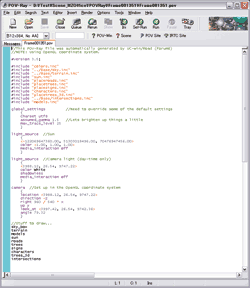 |
| Figure5 Example of POV-Ray project file |
Operational procedure
After reading the data, the POV-Ray script is output per frame with the
following procedures.
 |
| Figure6 Operational procedure, example of POV-Ray project file |
Contents of operation
AVI option
The size of image, the number of frames per second (FPS) are set.
POV-Ray option
The general topics of POV-Ray are set : Radiosity method, maximum trace
level, object output range, mist.
Movie option
The destination folders of AVI, AVI frame image, POV-Ray script data are
set. If they are not set, <User data folder>\Movie is automatically
used. You can select the data you want to export from above three data
in this dialog.
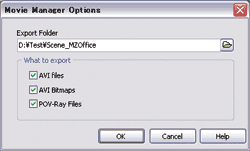 |
| Figure7 Movie option screen |
Output of static object
The information of model parts of the static model and dynamic model from
"Tools"-"Export Static Models to POV-ray". The frame
number is reset.
Start exporting the movie
The information of each frame starts to be output by selecting "Tools"-"Start
AVI recording", and they are added to the folder by frame.
End exporting the movie
The export ends from "Tools"-"Stop AVI recording".
The AVI file is confirmed once. AVI is named so that the start and end
of frame number become clear. If you select "Start AVI recording"
again here, it will be created from the frame number at that point.
Existing POV-Ray output
When you select menu "Tools"-"Export To POV-Ray", Output
of still object -->Output of Frame1 are performed in succession, and
POV-Ray is output at that timing as a result. The image after rendering
becomes same as the existing image.
Internal folder structure
The following folders are structured by setting the destination folder
in Movie Option dialog. The predefined files are output to each folder.
 |
|
AVI:
AVI file is output.
The start and end of frame become the AVI file name.
AVIBmp:
The images of each frame which are used for AVI file are output as the
frame number.bmp.
With this image and above movie, the result AVI of POVRay can be overviewed.
Base:
The static object information of POV-ray data is output as script.
FrameNNNNNN(N is 6 digits integer):
The dynamic data including POV-ray project information with each frame
number is output as script. |
| Figure8 Folder structure |
|
 |
 |
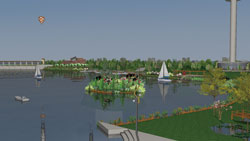 |
| Figure9 Result of POV-Ray rendering |
|
